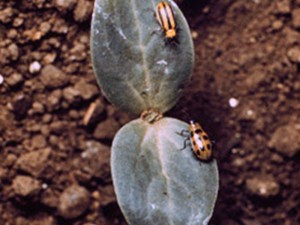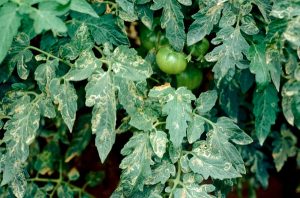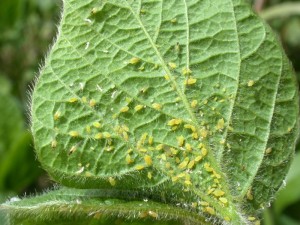It’s time to get up close and personal with the top garden pests eating our plants. During late summer I usually start to notice that some plants aren’t thriving, but I fail to get to the bottom of why not. So today we’re going to take a closer look at the top 3 most likely suspects – who they are, what they do, and how to control them using sustainable methods.
But first, a reminder to us all. The best defense against pests and disease is a healthy garden with robust soil and happy plants. Proper fertility, adequate water set up with a smart irrigation system, and attention to the needs of your plants are all great practices. The stronger your plants are the more damage they can withstand, and the less they’ll signal to pests that they’re weak and ready for the eating.
However, for when proactive measures fail (and they often do) here are some of my favorite go-to methods for dealing with these top garden pests.
Top Garden Pest #1: Cucumber Beetles

Who They Are:
Upon your first encounter with the cucumber beetle you may confuse him as some friendly cousin of the lady bug. Don’t be fooled! This round, black and yellow ladybug-sized pest is not your friend. Cucumber beetles overwinter in grasses and debris and find their way into your garden during early spring.
What They Do:
As their name suggests, the cucumber beetle loves cucumbers and other vegetables in the cucurbit family. But the love doesn’t stop there. For me they seem particularly drawn to my dahlias, zinnias, and even kale. They chew on many parts of the plant, but you can most clearly see their large bites on leaves and flower petals. If you find a hole about the size of a lentil, it’s probably from a cucumber beetle.
What to Do About Them:
Cucumber beetles cause the most havoc on plants that aren’t yet robust enough to live through the damage, so early intervention is key. There is no foolproof, 100% effective organic solution, but a combination of a few methods may do the trick. A great method is to simply cover the plants with remay or row cover. Do this early! Especially in spring, I cover my plants as soon as I’ve planted them in the ground and given them plenty of water. After a few weeks or once they’re bigger, you can test out removing the fabric.
Some gardeners have great success spraying neem oil to deter cucumber beetles. I think it’s worth a shot. In my humble opinion, neem oil is god’s gift to the organic gardener. A vegetable oil derived from the neem tree (native to India among other places), it’s a safe, easy-to-find and affordable spray that helps to smother not only aphids, but also cabbage worms, ants, leaf miners, and beetles. Most people dilute the oil to just 2% in water and spray repeatedly on an ongoing basis. It may also deter some beneficial insects, so don’t spray with abandon.
Then there are trap crops – these are plants you put in the garden that you don’t care too much about, that serve the express purpose of ‘trapping’ certain bugs. You can then squish them all or even use a vacuum to suck them up on a regular basis. But in all reality, this is probably a method better used on big gardens and farms.
And finally, the age old practice of when you see ‘em, squish ’em. Cucumber beetles are slow, easy to kill, and aren’t too gross to squish between your fingers. My old intern Michael kept a tally through the summer of how many he had killed – a ‘fun’ game for the kids.
Top Garden Pest #2: Leaf Miners

Who They Are:
It took me a while to recognize that I had leaf miner damage in my field because they’re too small to see! But they’re definitely one of the top garden pests in Sonoma County, and you’ll start to see their damage as a trail left on the leaves of your plants. When you take the leaf off and rip it up a little, you can sometimes find larvae in there – that’s your telltale sign.
What They Do:
The larvae continue to feed off your plants and grow. These trails or ‘mines’ that they leave in their wake are actually dead plant tissue.
What To Do About Them:
Again, growing crops under row cover is the best way to control the damage done by leaf miners. Beyond that, neem oil is said to work to varying degrees. And finally, to keep their population from growing rapidly, you can squish their white eggs which you’ll see on the backside of leaves.
Unlike much other bug damage, with leaf miners you’ll want to get rid of any infested leaves and get that material out of the garden all together. Just rip them off and discard as you come across them.
Top Garden Pest #3: Aphids

Who They Are:
Easily one of the top garden pests for me every year, there are thousands of species of aphids out there and they come in almost every color of the rainbow. But in my fields I tend to see black and green ones.
What They Do:
Aphids love fresh, tender new growth because that’s where they can most easily pierce through cell walls and suck gooey nutrient-rich sap out of your plants. They also particularly love the underside of leaves. Aphids secrete ‘honeydew’ which creates a great environment for mold to grow, and they carry and spread a whole range of diseases from plant to plant.
What To Do About Them:
It’s important to check your leaves frequently, because once they have started to curl due to aphid infestation, it’s harder to control an attack. If you find aphids on just one plant or one section of a few plants, it’s worth getting in there and simply cut out the whole part of the plant that is infested.
You can also spray the aphids off your plants with a hose. Of course you want to be careful to not damage young, tender plants, so don’t go too crazy. But most aphids that you spray off won’t return.
Neem and/or soap can also work if you spray them on your affected plants. To try household soap, dilute it to just 2 tablespoons per gallon, and spray on your plants to suffocate the aphids. Many people recommend spraying the soap residue off after a couple of hours so as to not burn the plants.
Many gardeners rely on solutions made of strong-smelling oils such as garlic, clove, rosemary, peppermint, and thyme. They are thought to deter and kill aphids when mixed into a spray bottle with water.
Finally, you can try introducing predatory insects. There are many known insects that feed on aphids. Ladybugs are a common one – either naturally occurring in your garden, or ones you buy and release outside. Parasitic wasps are also great natural predators, as well as soldier beetles and lady beetles.
Do you have a regular garden visitor that I didn’t cover in this list? Let me know in the comments below and share your best methods for dealing with them!







 Family
Family

